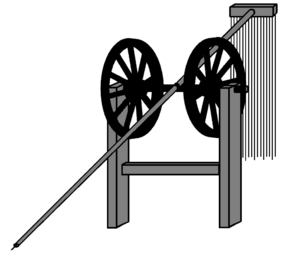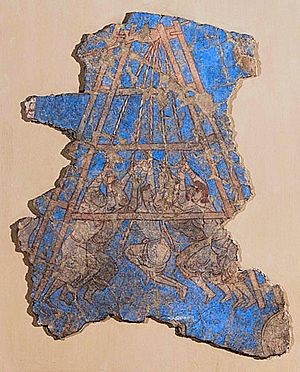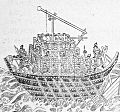Mangonel facts for kids
The mangonel, also known as the traction trebuchet, was an ancient war machine. It was like a giant slingshot used to throw large rocks or other objects during sieges, which is when armies tried to capture a city or castle.
Unlike later war machines that used heavy counterweights, the mangonel worked by people pulling ropes attached to a long arm. This pulling action launched projectiles far away.
Even though it needed many people to operate, the mangonel was simpler to build and faster to reload than other early siege weapons. It was first used in Ancient China and later spread across Eurasia. Over time, it was replaced by the more powerful counterweight trebuchet.
Contents
What's in a Name?
The word mangonel likely comes from the Greek word mangana, which was a general term for "construction machinery." It was a common name for medieval machines that threw stones.
In China, the mangonel was called the pào (砲). In Arabic, it had names like al-manjanīq. Modern historians often use the term "traction trebuchet" to make it clear that this machine was powered by people pulling, not by twisting ropes or heavy weights.
History of the Mangonel
Born in China
The mangonel is believed to have started in ancient China. People probably used these machines as early as the 4th century BC.
An old Chinese book called the Mojing describes a mangonel that was about 5.2 metres (17 ft) tall. Its throwing arm was long, about 9.1 to 10.7 metres (30 to 35 ft). People would pull ropes attached to the shorter end of the arm to launch things. These machines could throw projectiles up to 90 metres (300 ft)! They were often placed on city walls to defend against attackers. Sometimes, they even threw hollow logs filled with burning charcoal to destroy enemy siege equipment.
Mangonels were used in many important battles in China. For example, in 617, a general named Li Mi (Sui dynasty) built 300 mangonels to attack a city. Later, in 1161, Song dynasty soldiers used mangonels to fire bombs made of lime and sulfur at enemy ships during the Battle of Caishi.
Different Types of Chinese Mangonels
The Wujing Zongyao, another important Chinese military book, describes several types of mangonels:
- Whirlwind: This was a mangonel that could swivel around to shoot in any direction.
- Crouching Tiger: A medium-sized mangonel, stronger than the Whirlwind type.
- Four-footed: This was a very strong mangonel designed to throw heavier objects. Some of these needed as many as 250 people to pull them and could launch stones weighing over 125 pounds (56.7 kg)!
Spreading Across the World
The mangonel slowly spread westward from China. By the late 6th century AD, it appeared in the eastern Mediterranean. The Byzantines and Persians started using them. By the mid-7th century, the Arabs also adopted the mangonel. Like the Chinese, the Arabs even put mangonels on their ships.
Later, in the 8th century, the Franks and Saxons in Western Europe began using these machines. Mangonels were also used in India.
How They Were Used
Mangonels were most effective as weapons against groups of people. They were often used alongside archers and slingers to support attacks or defenses.
Some mangonels were incredibly large and powerful. At the Siege of Manzikert (1054), the Seljuks built a huge mangonel that needed 400 men to pull it. It could throw stones weighing 44 pounds (20 kg)! There are even stories of mangonels being able to throw a person. In 1161, a mangonel at the siege of Haizhou was said to have a range of over 1,300 feet (400 m).
Their Decline
West of China, the mangonel was the main siege weapon until the late 12th century. It was then replaced by the counterweight trebuchet, which used a heavy weight to power its throw, making it much more powerful.
In China, the mangonel remained the primary siege engine for longer. It was only replaced when the counterweight trebuchet was introduced during the Mongol conquest of the Song dynasty in the 13th century.
Images for kids
-
Crouching tiger trebuchet (stationary mangonel) from the Wujing Zongyao
-
Five whirlwind trebuchets (swivel mangonels) from the Wujing Zongyao
-
Mangonel on a Song Dynasty warship from the Wujing Zongyao
-
A Muslim mangonel from 1285.
See also
 In Spanish: Mangana para niños
In Spanish: Mangana para niños










